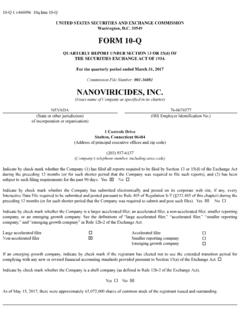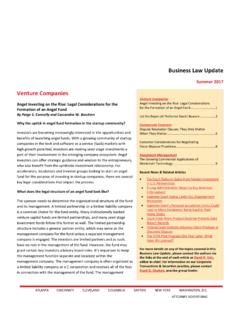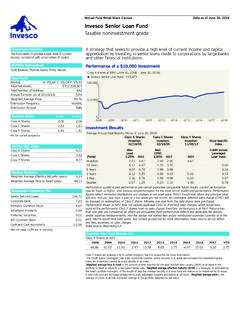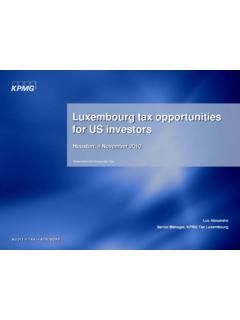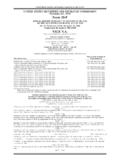Transcription of PREFERRED STOCK: STOCKS THAT ACT LIKE BONDS
1 PREFERRED STOCK: STOCKS that ACT LIKE BONDS . Fixed Income: PREFERRED Stock THE PREFERRED ALTERNATIVE Credit Risk Many individual investors wanting regular income at an PREFERRED stock typically receives a credit rating similar to attractive yield have been increasingly turning to a market BONDS . These ratings provide an indication of the likelihood that has long been dominated by corporations and that the issuer will continue to make timely dividend institutional investors PREFERRED stock. Preferreds are payments on their PREFERRED stock. Generally, an issuer's considered an equity security, but in reality PREFERRED stock PREFERRED stock ratings are two notches below issuer's senior is more similar to a bond. This security pays a fixed debt, which is reflective of the junior claim of the PREFERRED . dividend and typically yields two to four percentage points higher than dividend yields on common stock of the same Smaller Initial Investment issuer.
2 With most new PREFERRED issues offered at $25 per share, it usually takes a smaller commitment of funds to efficiently CHARACTERISTICS OF PREFERRED STOCK build a diversified PREFERRED stock portfolio than it does Senior Security with BONDS . PREFERRED stock is an equity security representing ownership in the issuing company and paying dividends that are Liquidity deemed to be senior to the dividends received by common Lower par values appeal to individual investors, which tends shareholders but junior to bondholders of the company. to broaden distribution of preferreds and enhance liquidity. Most PREFERRED shares are cumulative, meaning that the Unlike many other fixed-income investments, most preferreds dividends accrue if the issuer misses a payment. No are listed on major stock exchanges, which tends to improve dividends are paid on the common stock until the dividend visibility and strengthen marketability of the shares.
3 Payments on the PREFERRED stock are fully satisfied. Keep in Capital Gains Potential mind that unlike common stockholders, PREFERRED Preferreds offer the investor the opportunity for capital shareholders do not participate in the potential for appreciation. When preferreds trade at a discount to par, increased dividends. investors can invest in these securities relatively inexpensively Favorable Yields and earn a favorable yield on the dividends received, and Investors seeking improved yields and current income may should the outlook for the issuer become more favorable or find preferreds an attractive investment, with yields that interest rates fall, they can earn a capital gain on the shares. typically range between 1 2 to 3 4 percent higher than those Of course, capital losses are also possible if the share price available on an issuer's BONDS . deteriorates subsequent to the time of purchase.
4 Price Volatility THE DIVIDEND RECEIVED DEDUCTION. PREFERRED stock possess bond-like features, yet are not as FOR CORPORATIONS. price sensitive to interest rates. In general, prices will rise Corporations have historically invested in PREFERRED STOCKS as interest rates fall and prices will move lower as rates rise, because of the favorable tax treatment of the PREFERRED very similar to the price fluctuations of long-term BONDS . In stock dividends. corporations that are subject to addition, other factors affect prices, such as when certain corporate income tax are generally allowed to exclude industries come in and out of favor and/or other general 70 percent of the dividend income they receive from their market factors. taxable income. This is known as the dividend received deduction (DRD). Continued .. Fixed Income: PREFERRED Stock Page 2. In other words, for a company in the maximum 35 percent above, investors should be aware that most FRCS also have corporate tax bracket, the tax rate on dividends would be a dividend deferral option.
5 This allows the issuer to defer only percent. This is calculated as the taxable portion dividend payments for up to 20 quarters (five years). Most of the dividend (100% 70% = 30%) x 35% = In issues with this feature prohibit the company from declaring order to qualify for the DRD, the corporation must hold any common dividends until accumulated dividends on these securities for a minimum of 46 days, and the PREFERRED FRCS have been paid in full. Because FRCS are considered stock must be issued by a domestic corporation and be original issue discount (OID) securities for tax purposes, the structured as a straight PREFERRED issue and not a fixed investor would have to continue reporting and paying taxes rate capital security structure. on the dividend income, even if it is not paid by the company. PREFERRED STOCK STRUCTURES Foreign PREFERRED Stock Traditional PREFERRED Stock Also known as Yankee PREFERRED stock, these dollar Commonly known as straight PREFERRED , these securities denominated securities are issued in the by foreign represent an equity ownership in a publicly held domestic issuers.
6 Yields are typically higher than preferreds issued by corporation while having similar characteristics to BONDS . corporations, because Yankee preferreds are not Issuers, ranging from utilities and industrials to financial eligible for the DRD and typically have lower name institutions, pay a fixed quarterly dividend, much the same recognition than domestic preferreds. An important aspect as a traditional interest payment on a bond. With the of some foreign preferreds is the fact that the dividend may attraction of well-recognized issuers of preferreds that are be subject to a withholding tax imposed by the issuer's typically listed on the NYSE, individual investors also country. As an example, the United Kingdom imposes a benefit from the yields that are higher than comparable 15 percent withholding tax on shareholders. Investors fixed rate corporate BONDS , for example.
7 In addition, can reclaim this tax, however, if the shares are not held in investors benefit from the exchange-listed liquidity and a a tax-deferred account, by filing a tax credit on their tax fixed income stream that makes the PREFERRED stock more returns using Form 1116. stable then their common stock counterpart. Adjustable Rate PREFERRED Stock Fixed Rate Capital Securities Dividends on adjustable rate PREFERRED stock are reset While traditional PREFERRED stock has been available to quarterly to reflect market rates. The yield is adjusted to a investors for many years, a new type of PREFERRED was specified percentage of the higher of the 3-month Treasury developed several years ago, which has similar bill discount rate, the 10-year constant maturity Treasury characteristics to PREFERRED stock while allowing the issuing rate or the 30-year constant maturity Treasury rate.
8 These company to deduct the interest. Known as Fixed Rate securities are structured with minimum and maximum Capital Securities (FRCS), they have been issued under dividend yields known as collars , and they are DRD. various trademark names, including MIPS, MIDS, QUIPS eligible for corporations. Generally, the yield on these issues and TOPRS, but they generally fall into two basic would be lower than that of straight PREFERRED of the categories: same issuer. Individual and corporate investors benefit from adjustable rate preferreds by owning a security that Junior Subordinated Debentures These are the simplest potentially insulates them against adverse changes in the form of fixed rate capital securities. With this structure, shape of the yield curve, in addition to changes in the rather than setting up a separate company to issue PREFERRED absolute levels of interest rates.
9 Stock, the company issues the debentures directly to investors. Trust Originated Securities the name implies, these are issued by a trust. The proceeds of the PREFERRED stock issue are invested by the trust in junior subordinated securities issued by the parent company. In addition to having the characteristics of traditional PREFERRED stock mentioned Continued .. Fixed Income: PREFERRED Stock Page 3. TAX CONSEQUENCES Current Yield Dividends from traditional perpetual PREFERRED stock are The annualized dividend divided by the current PREFERRED reported on Form 1099-Div, similar to dividends on equity share price results in the current yield, which is a measure securities. Due to the dividend deferral option of Fixed Rate of the expected annual return on the investment. Example: Capital Securities, these issues are categorized as OID Shares paying an annualized dividend of $ with a (original issue discount) securities, even though they have a current price of $25 offer a current yield of , fixed rate coupon.
10 Because of this feature, dividends from calculated as follows: $ / $25 = most FRCS are reported on Form 1099-OID. FRCS that have been issued under the limited partnership structure Stripped Price report their dividends on Schedule K-1, and investors report The market price of PREFERRED shares minus the implied their dividends as partnership income. Since the income tax accrued dividend produces the stripped price. Example: laws are complex and always subject to change, investors Shares priced at $25 which have an accrued dividend of should discuss existing IRS guidelines with their tax $.31 per share have a stripped price of $ , calculated accountant or legal advisor. as follows: $25 $.31 = $ PRICE AND YIELD CALCULATIONS Stripped Yield The following are definitions and examples of some The annualized dividend divided by the stripped price common price and yield calculations related to PREFERRED results in the stripped yield.



